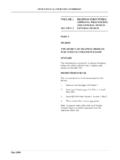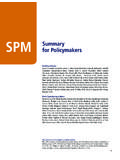Transcription of Baseline Indicators for Disaster Resilient Communities
1 Susan L. Cutter, Christopher T. Emrich, and Christopher G. BurtonHazards & vulnerability Research InstituteUniversity of South CarolinaColumbia, SC Indicators for Disaster Resilient Communities CARRI WorkshopJuly 14-15 Broomfield, COData issues Availability of variables (national, regional) Recent values (esp. Census) Role of census undercounts Coverage of variables (spatial & temporal) How to quantify unquantifiable?Example: Reliance on old socio-demographic data: SoVI SoVI for SC uses 32 variables based on 2000 Census American Community Survey provides more recent information (~2005) Places >65,000 Four variables unavailable (nursing home residents/capita; % rural farm populations; % social security recipients; % populations living in urban areas Only 20/46 SC counties have ACS updatesSoVI 2000/SoVI ACS comparisons SoVI score not significantly different Spatial representation changes: function of changes in % native American; % Asian, % Hispanic, median age, people per housing unit; % renters, % unemployment, per capita income, % rich, % poverty, % agricultural employment, median contract rent.)
2 Median housing valueCreating the Baseline : Steps Theoretical or conceptual framework Indicator selection criteria Assessment of measurement error Imputation of missing data Index structure (inductive or statistical vs. deductive or theory) Data transformation (per capita; density, absolute) Normalization (scaling & standardization) Multivariate analysis Weighting (for each component or variable) Aggregation (how combine into final product) Sensitivity analysisResilience Indicators :Components for Baseline Ecological Social Economic Infrastructure Institutional capacity (mitigation) Community competenceCARRI white papers; Norris et al. 2008; Cutter et al. 2008 Theoretical frameworkEcologicalVariableSourceEffect on Resilience% Land area in 100-year flood plainCutter et Land area subject to SLRC utter et Soil erosionCutter et Green space/undisturbedlandCutter et Urban (access variable)Cutter et Forested land cover (wildfire potential) Cutter et Land with hydricsoils(liquefaction)Cutter et Wetland loss (ecosystem services)Gunderson 2009negativeIndicator selectionSocialVariableSourceEffect on ResilienceRacial/ethnic inequality ( of difference in % black & % white)Norris et al.
3 2008; Cutter et al 2008negativeEducational inequality (Abs. value of difference less than 9thgrade & college)Norris et al. 2008; Morrow 2008negativePhysicians/10,000 (health access)Norris et al. 2008positiveElderly (%)Morrow 2008negativeSocial vulnerability index (SoVI)Morrow 2008; Cutter et al. 2008; Tierney 2009negativeTransport challenged (% no vehicle)Tierney 2009negativeCommunication challenged (% no phone)Colten et al. 2008negativeLanguage competency (% ESL)Morrow 2008negativeCrime rate (per 10,000)Colten et al. 2008negativeSpecial needs (% popwith disabilities)Heinz Center2002negativeHealth coverage (% pop with coverage)Heinz Center2002positivePopulation wellness (% black infantmortality rate)Norris et al. 2002, 2008negativeVariable TransformationsEconomicVariableSourceEff ect on ResilienceHousing capital ( difference % white homeowner and % black homeowner)Norris et al.
4 2008negativeHomeowners (%)Norris et al. 2008; Cutter et al. 2008positiveEmployment (%)Mileti1999positiveMedian household incomeNorris et al. 2008; Cutter et al. 2008positivePoverty(%)Norris et al. 2008; Morrow 2008; Enarson2007negativeSingle sector employment (% primary sector + tourism)Berke & Campanella2006negativeFemale labor force participation (%)NRC 2006positiveBusiness size (% large >100 employees)Norris et al. 2008positiveInstitutionalVariableSourceE ffect on ResilienceRecent hazard mitigation plan (yes/no)Burbyet al. 2000; Godshalk2007positiveNFIP policies (peroccupied housing unit)Tierney et al . 2001positiveStorm Ready participation (yes/no)Multi-hazardMitigation Council 2005; Tierney et al . 2001positiveMunicipalexpenditures (fire, police, emergency services as a %)Sylves2007positiveInfrastructureVariab leSourceEffect on ResilienceMobile homes (%)Cutter et al.
5 2003negativeSheltercapacity (% rental vacancy)Tierney 2009positiveMedical capacity(hospital beds/10,000)Auf derHeideand Scanlon2007positiveBuildingpermits for new construction (#)NRC 2006negativeEvacuation potential (arterial miles/mi2)NRC 2006positiveEvacuation potential(# highway bridges)General knowledgenegativeHousing age (% built1970-1994)Mileti1999negativeCommuni ty CompetenceVariableSourceEffect onResiliencePolitical fragmentation (#local governments and special districts)Norris et al. 2008negativePrevious disasterexperience (PDD, yes or no)Cutter et al. 2008positiveSocialconnectivity (VOADs yes or no)Morrow 2008; Norris et al. 2005positiveDependency ratio (debt/revenue)Cutteret al. 2003negativeInternationalmigration (%)Morrow 2008negativeSense of place (% borne in state and still live here)Vale & Campanella2005positiveSocial capital (churches/capita)Morrow 2008; Tierney 2009positiveSocial capital (% registered votersvoting in 2004 election)Cutter etal.
6 2003positiveInternal migration (% outmigration)Vale and Campanella2005negativeScaling Example====Common scaling techniques:Z-scoresLinear scaling, Min-max transformationLinear scaling, maximum value transformationNormalizationPutting it all together Linear min-max scaling: X-min/max-min Purpose: scale values from 0 to 1 where 0 reduces resilience; 1 increases resilience Scores theoretically range from -27 to +21; actually range from to + order of countiesMost Resilient Jasper Lee Saluda Williamsburg DillonLeast Resilient Lexington Kershaw Greenville Calhoun HorryMapping Results464544434212345 Category WeightingCommon weighting schemes:Equal weightsUnequal weightsWeightingEcological17%Social25%Ec onomic17%Institutional8%Infrastructure14 %Community competence19%Unequal WeightsEcological16%Social16%Economic17% Institutional17%Infrastructure17%Communi ty competence17%Equal WeightsNew map with equal weightsComponents of ResilienceIdentifying the dimensional drivers CountyEcologicalSocialEconomicInfrastruc ture InstitutionalCommunity values for each dimensionSC strong on institutionalIllustrates opportunities for interventionNext steps Refine present methodology (variables, analytical techniques) Different aggregation schemes (PCA) National comparisons (coastal counties, other regions) Downscale to sub-county ( Communities , census tracts)
7 Couple Baseline Indicators with process-oriented capacity building for Disaster resilienceThanks and come for a





